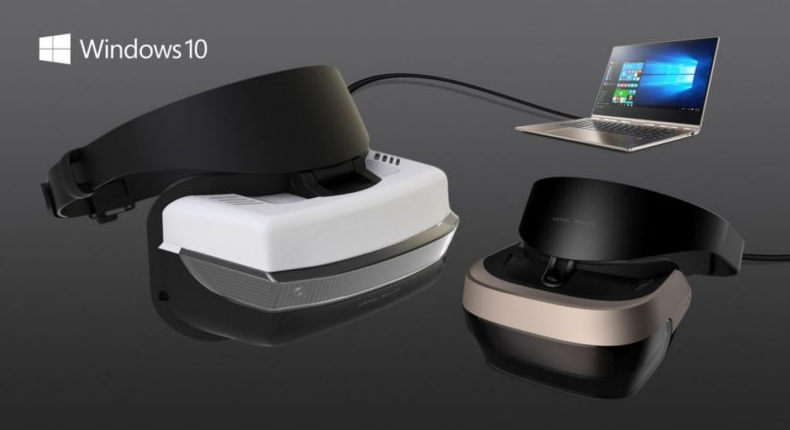
At a high-profile New York City event Oct. 26, Microsoft announced its own virtual-reality headset, putting the company in direct competition with Google, Facebook, Sony, and HTC. Microsoft is positioning the devices as “affordable,” with a $299 price point meant to undercut Facebook’s Oculus Rift ($599) and HTC’s Vive ($799). That’s also significantly lower than Microsoft’s own HoloLens augmented-reality headset, which costs $3,000 for a developer model. Given Microsoft’s size, as well as the extent of the Windows ecosystem to which its VR efforts will inevitably be linked, these new headsets instantly change the makeup of the virtual-reality market. Hewlett-Packard, Dell, Asus, and Acer are partners on the hardware side of things; although details at this early stage remain scant, there’s always the possibility that these companies will introduce their own features and variations on the core platform, much as they do with PCs. How might the market change? Until today, Google and Samsung were the major players in the “cheap” VR space. Samsung’s Gear VR is a $99 headset that requires a Samsung phone to use. Google, meanwhile, has issued two generations of cheaper hardware, starting with
Cardboard, a 21-century update on the stereoscope that relies on the user’s smartphone as the screen; then came the Daydream VR headset, also powered by (Android) smartphones, which features a handheld controller and a $79 price point. Microsoft comes into the VR arena with certain built-in advantages. Thanks to the Xbox, it already boasts an extensive ecosystem of experienced game developers, who could prove useful in building out a large portfolio of VR games. Picture shooting it out with some sort of slavering space alien in glorious 3D; you'll either love it, or the ultra-realistic immersion will make your stomach churn:

If Microsoft’s army of in-house engineers has figured out how to run the headset off older PCs with reduced processing power, it could give the company an additional audience advantage over higher-end systems such as the Oculus Rift, which demand high-end gamer PCs in order to run software. Microsoft’s quarterly cash flow also ensures that it can invest in its VR efforts for the long term. But that being said, the company has a mixed record when it comes to attracting developers to its platforms. Windows Phone, its aggressive push into mobile, ended up crushed by iOS and Android; and despite the near-ubiquity of Windows on desktops, many developers have preferred to devote their time to alternative platforms. And those developers are as key to any company’s VR success as the price-point on hardware. Microsoft could become a force to be reckoned with in virtual reality, especially if the legions of Xbox gamers decide to use its platform to explore 3D worlds; but unless the company can attract the tech pros necessary to help it build out its offerings, it will be stuck fighting tooth-and-nail with Google, Samsung, and other players for mid-market supremacy.
 At a high-profile New York City event Oct. 26, Microsoft announced its own virtual-reality headset, putting the company in direct competition with Google, Facebook, Sony, and HTC. Microsoft is positioning the devices as “affordable,” with a $299 price point meant to undercut Facebook’s Oculus Rift ($599) and HTC’s Vive ($799). That’s also significantly lower than Microsoft’s own HoloLens augmented-reality headset, which costs $3,000 for a developer model. Given Microsoft’s size, as well as the extent of the Windows ecosystem to which its VR efforts will inevitably be linked, these new headsets instantly change the makeup of the virtual-reality market. Hewlett-Packard, Dell, Asus, and Acer are partners on the hardware side of things; although details at this early stage remain scant, there’s always the possibility that these companies will introduce their own features and variations on the core platform, much as they do with PCs. How might the market change? Until today, Google and Samsung were the major players in the “cheap” VR space. Samsung’s Gear VR is a $99 headset that requires a Samsung phone to use. Google, meanwhile, has issued two generations of cheaper hardware, starting with Cardboard, a 21-century update on the stereoscope that relies on the user’s smartphone as the screen; then came the Daydream VR headset, also powered by (Android) smartphones, which features a handheld controller and a $79 price point. Microsoft comes into the VR arena with certain built-in advantages. Thanks to the Xbox, it already boasts an extensive ecosystem of experienced game developers, who could prove useful in building out a large portfolio of VR games. Picture shooting it out with some sort of slavering space alien in glorious 3D; you'll either love it, or the ultra-realistic immersion will make your stomach churn:
At a high-profile New York City event Oct. 26, Microsoft announced its own virtual-reality headset, putting the company in direct competition with Google, Facebook, Sony, and HTC. Microsoft is positioning the devices as “affordable,” with a $299 price point meant to undercut Facebook’s Oculus Rift ($599) and HTC’s Vive ($799). That’s also significantly lower than Microsoft’s own HoloLens augmented-reality headset, which costs $3,000 for a developer model. Given Microsoft’s size, as well as the extent of the Windows ecosystem to which its VR efforts will inevitably be linked, these new headsets instantly change the makeup of the virtual-reality market. Hewlett-Packard, Dell, Asus, and Acer are partners on the hardware side of things; although details at this early stage remain scant, there’s always the possibility that these companies will introduce their own features and variations on the core platform, much as they do with PCs. How might the market change? Until today, Google and Samsung were the major players in the “cheap” VR space. Samsung’s Gear VR is a $99 headset that requires a Samsung phone to use. Google, meanwhile, has issued two generations of cheaper hardware, starting with Cardboard, a 21-century update on the stereoscope that relies on the user’s smartphone as the screen; then came the Daydream VR headset, also powered by (Android) smartphones, which features a handheld controller and a $79 price point. Microsoft comes into the VR arena with certain built-in advantages. Thanks to the Xbox, it already boasts an extensive ecosystem of experienced game developers, who could prove useful in building out a large portfolio of VR games. Picture shooting it out with some sort of slavering space alien in glorious 3D; you'll either love it, or the ultra-realistic immersion will make your stomach churn:  If Microsoft’s army of in-house engineers has figured out how to run the headset off older PCs with reduced processing power, it could give the company an additional audience advantage over higher-end systems such as the Oculus Rift, which demand high-end gamer PCs in order to run software. Microsoft’s quarterly cash flow also ensures that it can invest in its VR efforts for the long term. But that being said, the company has a mixed record when it comes to attracting developers to its platforms. Windows Phone, its aggressive push into mobile, ended up crushed by iOS and Android; and despite the near-ubiquity of Windows on desktops, many developers have preferred to devote their time to alternative platforms. And those developers are as key to any company’s VR success as the price-point on hardware. Microsoft could become a force to be reckoned with in virtual reality, especially if the legions of Xbox gamers decide to use its platform to explore 3D worlds; but unless the company can attract the tech pros necessary to help it build out its offerings, it will be stuck fighting tooth-and-nail with Google, Samsung, and other players for mid-market supremacy.
If Microsoft’s army of in-house engineers has figured out how to run the headset off older PCs with reduced processing power, it could give the company an additional audience advantage over higher-end systems such as the Oculus Rift, which demand high-end gamer PCs in order to run software. Microsoft’s quarterly cash flow also ensures that it can invest in its VR efforts for the long term. But that being said, the company has a mixed record when it comes to attracting developers to its platforms. Windows Phone, its aggressive push into mobile, ended up crushed by iOS and Android; and despite the near-ubiquity of Windows on desktops, many developers have preferred to devote their time to alternative platforms. And those developers are as key to any company’s VR success as the price-point on hardware. Microsoft could become a force to be reckoned with in virtual reality, especially if the legions of Xbox gamers decide to use its platform to explore 3D worlds; but unless the company can attract the tech pros necessary to help it build out its offerings, it will be stuck fighting tooth-and-nail with Google, Samsung, and other players for mid-market supremacy. 
